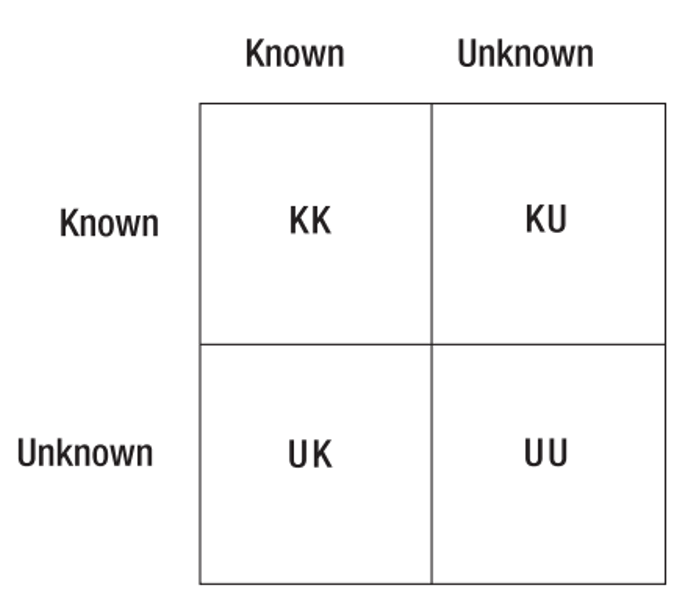“There are known knowns.” This is the response U.S. Secretary of Defense Donald Rumsfeld gave to a question when discussing Iraq at a news briefing in 2002. His reference prompted immediate study of the UNK-UNK Chart, derived from looking at the numerous variations of unknown and known information elements. The chart is useful for military planning and for commercial risk analysis. However, the UNK-UNK chart can also be useful in identifying and understanding what you know and don’t know about yourself.
known unknown matrix
The known unknown matrix is broken into four quadrants. The quadrants use the terms “known” and “unknown.”, referring to a general understanding of information you have an awareness of (“knowns”) and information not known (“unknowns”). When you array these two terms on both sides of the chart and step through the analysis, an approach to reducing your “unknowns” begins to unfold.

Known Knowns (KK)
Starting with the upper left quadrant – Known Knowns (KK) or information you know you know, is a very valuable commodity. In this quadrant, the organization is “self-aware”, and this knowledge can be exploited. By way of a military example, if you know you know the location of the enemy, you can plan and move to contact to destroy the enemy at this location. Similarly, in business, a corporation would want to try to exploit its capabilities in the marketplace if they knew they had a competitive advantage. From a personal perspective, your skills, characteristics, abilities, and sense for the type of marketplace you want to pursue are very valuable. Acknowledge and exploit this information on your resume and during your interviews to achieve the best career alignment.
Known Unknowns (KU)
The upper right quadrant – Known Unknowns (KU), or knowing what you do not know, denotes an organization, which understands they do not have certain information elements needed for success. Capturing these information elements provides tremendous value for improvement within the organization. For example, if a company does not have market information, they work to resolve the shortfall to increase their competitive advantage. From a personal perspective, knowing that you do not have a capability is of vital importance. During an interview, not knowing the hiring manager’s expectations and how the organization perceives value can bring the interview process to a halt. If you know you are missing information, take time to reduce your competitive risk. KU elements become your goals. Achieving these associated goals turn KUs into KKs, increasing your competitive edge.
Unknown Knowns (UK)
UK is the bottom left quadrant (things you don’t know, you know), which is very harmful in combat. When critical information is not shared, it can cause mission failure. A company may know they have a capability, but fails to see its value and their competitor gets to market faster. During your personal transition, apply this quadrant to ensure you have uncovered all your capabilities, even the ones you do not expect to be significantly marketable. During interviews, take time to share your accomplishments, certifications, and experiences as they relate to the company.
Unknown Unknowns (UU)
Finally, the bottom right quadrant UU (information you don’t know that you don’t know) is all about reaction. “Ignorance is bliss” is a common cliché associated with this quadrant. When actions occur rapidly, you may lose out if you do not have the information necessary for counter action. This is the riskiest quadrant as there are unexpected outcomes, due to lack of knowledge.
What’s the Point?
Why go through this analysis using the UNK-UNK chart? Your objective is to reduce the size of any unknowns and associated risks. As shown in the figure below, reducing your level of “unexpected unknowns” and turning them into “knowns” is the best method to increase your personal edge and confidence. There will always be “unknown” shortcomings, but it is essential to reduce the ‘unknown’ quadrant as much as possible by expanding other quadrants, making your ‘known’ area as large as possible. For this to happen, reflect upon your undiscovered skills and characteristics. Use the knowledge you gain from the UNK-UNK chart to determine what you can exploit and what areas you need to improve upon.
Read more about change and transition in The Transitioning Military Project Manager and other books from The Transitioning Military Series at Gr8Transitions4U.com.



